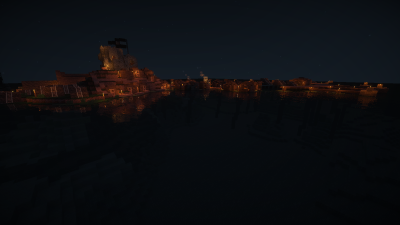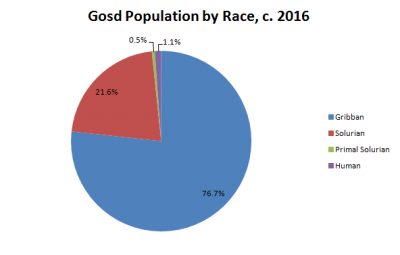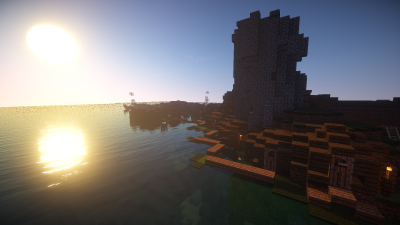Gosd
Overview
History

Gosd is an oddity in the Solurian Empire. Gosd was founded sometime during the First Age by colonists from the southern city of Grib. Colonization was done by the Gribban Compact, a small southern empire begun by the residents of the mushroom city of Grib. It began as a small establishment that was to supply wood products and lumber to the capital city of the Gribbans, but eventually was the first point of contact between the budding Solurian Empire and the people of Grib. Since the first contact in 312, Gosd was used as a stopping point for traders going from the cities of the Solurian Empire to cities of the Gribban Compact.
The Griblings were at first worried about contact with a fast growing empire such as the Solurian Empire, but the way the two separate races worked together mollified some of this fear. Shortly after an official meeting between civil and military leaders of both groups, the Treaty of Gosd was signed in 1018, allowing free trade between the two empires and establishment of embassies, among other things. Under this treaty, trade between the two empires flourished. With this treaty, the town of Solentse was brought into a trade route from Grib to Gosd, allowing for the town to prosper.
Trade continued into 1702, until a small group of racist extremists burned three full lily pads in an act of terror. Three of the extremists were caught fleeing south by Gribban military forces off the coast of Solenste, which was a small trading town at the time, and were brought back to Gosd for execution. Two more remaining terrorists were caught by the Solurian Navy off the coast of Alwasy, when they were attempting to flee north. These two were returned to custody of the Gribban military, and were summarily executed for their part in the crimes.
The aid given by the Solurian Empire in bringing these people to justice bolstered the relations between the two empires. Shortly after, in 1703, under the permission of the Gribban Compact, the Solurian Empire set up a small fort (which remains standing to this day, nearly 1000 years later). The fort has since deteriorated due to prior battles and the unstable foundations of the swamp in which it was built.
Due to their past experience in the swamps of Gosd and the main source of revenue being woodworking, the citizens of Gosd were revered as master carpenters and woodworkers. However, the homes they had on the island were not enough to sustain the growing population. With the help of mages from the Solurian Empire, the residents of Gosd were able to properly seed and grow several lily pads to replace those burned by the terror attacks, and their life on the shores of the swamp continued peacefully.

Gosd during the Civil War
During the Solurian Civil War of 1717, Gosd was considered one of the front lines between forces of the Avetissmens and the members of the Gribban Compact. This was due to the dangerous and borderline racist ideals the Avetissmens were trying to spread to gain control of the Solurian Empire. These ideals often took rights and freedoms away from non-human Solurians, and the Gribban Compact, which was considering merging with the Solurian Empire, knew that the Avetissmens would not stop there. Thus, the Gribban Compact sided with the Primal Solurians in their fight against the Avetissmens, and the role of Gosd in the war was cemented.
The First Battle of Gosd occurred in early 1718, when mercenary forces of the Avetissmens, based at a small landing site northwest of Gosd, attempted to move into Gosd through the swamp. These forces likely wished to use Gosd as a launching point for various raids and attacks on Solurian naval supply lines. However, using guerrilla warfare, members of the village and soldiers at the fort chipped away at the mercenaries as they attempted to pass through the swamp. The combination of the terrain, the lack of knowledge of the terrain, the plentiful cover for ambushes, and the difficulty in getting supplies and siege weapons through the swamp proved fatal for the attacking force. Nearly half of the mercenary force was killed in the swamp, and the remaining half were defeated soundly at the lumberyard of Gosd, where members of the Gribban and Solurian Armies had entrenched. As such, Gosd became renown as unassailable from the land. The main worry, however, was how easy an attack by sea could take the town. Thus, the lily pads were armored and reinforced at the deep ocean stems, allowing for defense from a naval blockade.
The Second Battle of Gosd occurred in late 1718, when a large naval force of the Avetissmens attempted to lay siege to and raze Gosd to eliminate the supplies the Gribban Navy could use. After three days of bombardment, however, the small fort of Gosd stood strong, and the lily pads of Gosd remained floating. On the fourth day, a combined force of the Solurian Navy out of Solentse and the Gribban Navy out of Grib moved north from the Naval Battle of Tibeth and were able to successfully break the blockade and sink 18 ships of the Avetissmens naval force. Thus, the Second Battle of Gosd was ended, and a great victory for the Solurian Empire was won. A few ships of the Solurian Navy remained with the Gribban Navy, while the rest continued north to begin what would later be known as the Siege of Mar. Due to the skill of the Gribban and Solurian Navies, assault by water was also now nigh-impossible.
When the Solurian Civil War of 1717 ended in 1719, the additional fortifications added to the town of Gosd were removed and the town returned to its roots of woodworking and lumber exportation. The next year, in 1720, the Gribban Compact joined the Solurian Empire, and Gosd became a full-fledged town of the Solurian Empire.
Modern-day Gosd
The Gosd of today is a peaceful town, recognized widely by its small homes and the lily pads upon which these homes reside. Gosd contains four medium sized lily pads, which house three to four homes each, and one large lily pad, which houses the small fishing harbor and the storage warehouse. On the island, Gosd has multiple homes, a small bar, the iconic Gosd fort, and the lumber mill where most of the wood gathered from the swamp is cut.
In the current day, Gosd-made lumber, furniture, tools, and planks remain the highest quality available in nearly the entire western hemisphere. Gosd is also an exporter of high quality herbs and swamp plants. Most Gribbans living in Gosd keep stores of books on herbs and swamp plants in their home, due to the possible poisonous nature of the large variety of plants in the area. It is predicted that by the end of 2018 Gosd will have a small herbal research base funded by the Sol Greenery Co.
Plant Life
Since Gosd is located on the coast of one of the larger swamps in the shire, the plant life that can be found is often quite random and exotic. From records dating back to 1023, when visiting Solurians began working with the Gribbans to detail plant life, over 5,000 species of vegetation have been found. Some flowers, like the Dandelion, Poppy, Allium, Azure Bluet, Tulip, and Oxeye Daisy can be found in a large variety of landscapes around the Shire. The Blue Orchid, however, was initially native only to the swamp outside of Gosd, but grew rapidly when introduced into other swamp areas by smugglers looking to expand the blue dye trade. Now, the Blue Orchid can be found nearly anywhere, and is considered an invasive plant species in the northern and eastern parts of the Shire. Due to its invasive nature, the Blue Orchid has slowly killed off other flower species in nearly every swampland of the Shire.
Gosd also happens to be where the Sol Greenery Co found and cultivated the rare Sheep-Eating Flytrap which is housed in the Laurelian Flora Museum. Where exactly the plant originated from is unknown, but it was found deep in the swamplands west of Gosd as a small seed, and was cultivated into the size it is today. Researchers are unsure whether it will stop growing or not, and have been unable to find further examples of the species even to this current day.
Demographics
The population of Gosd is understandably small, as Gosd is one of the smaller towns in the Solurian Empire. When the census was last taken in 2016, the population of Gosd was 18,912 Gribbans, 2329 Solurians, 1734 Primal Solurians, and 278 humans.

Like Grib, Gosd is populated mostly by Gribbans, with the gribban population nearly tripling the total combined population of the other races. However, unlike Grib and most of the Solurian Empire, Gosd has no recorded permanent citizens of Sammichian, Enpeecee, Enderian, Acadian, or Laurelii descent, as of the 2016 census.
Religon
The religion of Gosd is the same as the main religion for the Solurian Empire, the Solurian Sect. With the last census in 2016, over 98% of the population of Gosd followed the religious beliefs of the Solurian Sect. The remaining two percent of the population were either nonreligious or followed a separate religion which was not stated on the census. Religious life in Gosd has been prevalent since the introduction of the Solurian Sect into Gosd in 313, a mere year after first contact with the Solurian Empire. Since then, the religion gained believers until it became the majority religion in 417, and continued until 445 when it was declared the official religion of Gosd. When the Gribban Compact merged with the Solurian Empire in 1720, Gosd joined Grib in welcoming the Solurian Sect as the official religion of their combined empire. Until recently, Gosd has not had a specific area for worship and religious activity, instead using the surrounding land as a natural religious area. However, since the population has grown so much, town officials have begun the process of contracting and designing a small religious temple, possibly even on its own freshly-grown lily pad.
Build History

Gosd was a small village started by Master_Chief on the 28th of June, 2015. He completed the lily pad portion of the village on the same day, and finished the island portion on the 29th of June, same year. After completion of the village, the warp gosd was added. Possible additions of lily pads and expansion into the swamp are planned, but it is unsure if they will occur.